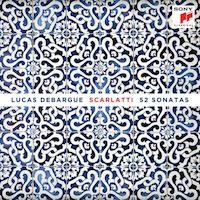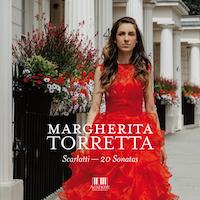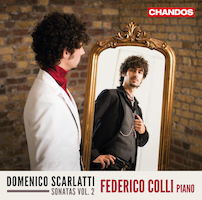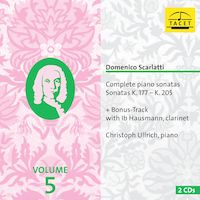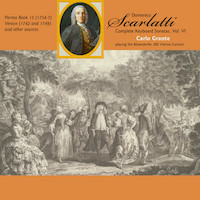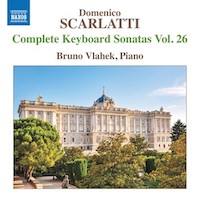Piano Factory 29. / Scarlatti para siempre 2.
|
Grant Chu Covell [October 2021.] “To the reader who skips around… You read my entire novel without knowing it, because I scattered the telling of the whole novel before I started, and so you turned into an unknowing orderly reader.” (Return to part one.)
“52 Sonatas.” Domenico SCARLATTI: Var. Sonatas. K. 206, 531, 404, 405, 447, 25, 343, 113, 258, 214, 211, 212, 109, 6, 268, 443, 45, 27, 244, 105, 260, 491, 414, 534, 535, 32, 431, 125, 308, 461, 196, 477, 115, 526, 462, 438, 106, 107, 69, 468, 469, 302, 242, 521, 14, 474, 253, 172, 545, 192, 193, 247 (ca. 1738-57). Lucas Debargue (pno). Sony 19075944462 (4 CDs) (www.sonyclassical.com). Debargue admits his starting point is Ross’ harpsichord edition and that his program’s particular quantity (52) can suggest the number of cards in a deck or the number of weeks in the year. Unlike Ross, Debargue is a measured Romantic. Debargue’s 9.369% journey offers pairs, but each disc concludes with a single slow and contemplative sonata. Finishing disc two, Debargue renders the simple K. 32 grandly. Its last notes are not held, so the sonata stops, suddenly hushed. The entire series closes with a deliberate K. 247. On disc one, the F-sharp minor pair K. 447 and 25 contrasts a presumably later sonata with an earlier one (leaner harmonies, independent hands, bolder but logical contrasts). Kicking off disc three, perhaps the shortest thing Scarlatti wrote, K. 431, in 16 quick bars (0:56), is followed by K. 125’s electric sprint. Debargue’s pairings are either his own or reflect Kirkpatrick’s numbering and/or the sequence in the Parma and Venice collections. Lacking any evidence, the copyist’s order may be the closest indication we have of Scarlatti’s intentions. If you are listening closely (or desire to build a bigger picture), the “legit” pairs K. 404 and 405, 211 and 212, 534 and 535, 468 and 469, 192 and 193 open onto a different vista. In the same keys, the pairs complement each other thematically and metrically (they can often relate harmonically, in that taken as a pair there may be an increased variety of harmonic relationships).
“Scarlatti: 20 Sonatas.” Domenico SCARLATTI: Var. Sonatas. K. 426, 135, 158, 118, 119, 32, 515, 213, 425, 3, 132, 27, 262, 294, 380, 377, 101, 125, 98, 492 (ca. 1738-57). Margherita Torretta (pno). Academy Productions AP 2462 (1 CD) (www.academy-classical-music.com). “Sonatas, Vol. 2.” Domenico SCARLATTI: Var. Sonatas. K. 144, 427, 25, 318, 431, 40, 30, 35, 466, 531, 63, 64, 279, 118, 87, 95 (ca. 1738-57). Federico Colli (pno). Chandos CHAN 20134 (1 CD) (www.chandos.net). If you like Chopin and Rachmaninoff, then Torretta’s Romantic Scarlatti will suit. Her rubato is not distracting, and she applies fluctuating dynamics and a gamut of attacks. The slow K. 426 offers a canvas for expression. These keyboard works do not seem to be paired or grouped, although K. 125 and 98, in G major and E minor, comprise a lively sequence. K. 119 may be faster elsewhere (especially on harpsichord). Generally, Torretta doesn’t view Scarlatti as a vehicle for virtuosity, she expressively shapes rapid passages which slightly slows them. Debargue files through K. 125 at 2:14 (with repeats) whereas Torretta is 2:26 (with repeats). Colli offers 16 sonatas in eight pairs. He takes liberties on repeats, adds ornaments, rolls chords and transposes phrases. Colli pairs the diminutive 16-bar K. 431 (0:52) with K. 40, a one-page “Minuetto.” One of the saddest sonatas Scarlatti ever wrote, K. 466, in F minor, sits near the center of his program. Small harmonic and melodic gestures are repeated and become poignant. Colli concludes with K. 95 which may not be by Scarlatti. He forgoes repeats and proceeds slowly to obscure the uncharacteristic left-hand arpeggiated figuration.
“Complete Piano Sonatas, Vol. 5.” Domenico SCARLATTI: Var. Sonatas. K. 177, 178, 179, 180, 181, 182, 183, 184, 185, 186, 187, 188, 189, 190, 191, 192, 193, 194, 195, 196, 197, 198, 199, 200, 201, 202, 203, 204a, 204b, 205 (ca. 1752). Ib HAUSMANN and Christoph ULLRICH: Scarlark* (2020). Christoph Ullrich (pno), Ib Haussmann* (clar). Tacet 0267-0 (2 CDs) (www.tacet.de). Ullrich’s approach sticks to Kirkpatrick’s numbering. His Vol. 5 offers K. 177 to 205, including the distinct K. 204a and 204b. (17 volumes are projected for a project that will complete in 2028.) The completist ought to take a different perspective because confronted with a fixed program he or she must make more of an effort discover and express the sonatas’ intrinsic shape and uniqueness. If Debargue is a pianist graciously presenting Scarlatti’s mysteries, Ullrich has less ego and we hear more of Scarlatti’s idiosyncrasies. (Actually, this sequence offers most of a Venice volume and a handful from a Parma volume, the order reflecting Kirkpatrick’s design.) Ullrich plays cleanly and securely; it’s like having a trusted driver take over a representative leg of an interstate trip. K. 177 is an apt opener, sounding fresh in D major, one of Scarlatti’s favored keys. Here and elsewhere Ullrich takes small liberties (octave transposition, ornamentation) to enliven the journey. K. 180 embeds the strange wedge modulation which sounds harsher on harpsichord, here it sounds like Ullrich might be adlibbing. K. 192 concludes with a delicate coda of repeated notes. K. 204a (completely different from 204b) dramatically alternates two tempos. This volume includes a curious lagniappe: An improvisation with clarinetist Ib Haussmann. Once complete, Ullrich’s series will be formidable.
“Scarlatti: The Complete Keyboard Sonatas, Vol. 6: Parma Book 15 (1756-57), Venice (1742 and 1749), and other sources.” Domenico SCARLATTI: Var. Sonatas. K. 514, 515, 516, 517, 518, 519, 520, 521, 522, 523, 524, 525, 526, 527, 528, 529, 530, 531, 532, 533, 534, 535, 536, 537, 538, 539, 540, 541, 542, 543, 544, 545, 546, 547, 548, 549, 550, 551, 552, 553, 554, 555, 45, 51, 52, 58, 59, 60, 61, 62, 63, 64, 36, 65, 38, 66, 67, 68, 70, 71, 72, 73, 74, 75, 76, 37, 77, 33, 78a, 94, 79, 80, 81, 82, 83, 84, 85, 86, 88, 89, 90, 91, 31, 92, 93, 102, 103, 117, 95, 97, 145, 146, 141, 142, 143, 144, 452, 453, 147, 35, 39, 40, 42, 32, 34, et al. from misc. sources (ca. 1738-57). Carlo Grante (pno). Music and Arts CD-1299 (7 CDs) (www.musicandarts.com). Grante’s collection is recently complete, six volumes offering 35 discs. With Grante we take an invigorating stroll to the top of the mountain where we can enjoy the views. From the apex geological features will be self-evident as will the colors and sounds of rare birds. Grante employs a Bösendorfer, whose extra range isn’t necessary for these pieces, however the meaty tone is just slightly different from most pianos. In his writings on Scarlatti, Kirkpatrick persuasively argues against the Romantic tendency to color Scarlatti with dynamics, echo effects, excessive articulations, and the like. Grante’s playing is lean but bold, letting Scarlatti’s repeats, octave shifts, intentionally thin chords, etc. speak for themselves. Contrasting with Debargue and Ullrich, Grante and Ullrich are deceidely in the same camp, playing the long game, producing considered phrases and letting Scarlatti’s genius speak for itself. I hear Grante introducing very subtle pauses and rubato, as if to say, “look what happens here,” and to gently guide us towards the unexpected and clever. In K. 468 there is a momentarily strange chromatic passage which permits Debargue to step forward impressionistically whereas Grante (Vol. 5) lets us in on a joke: I hear the section as a written-out example of a mistake, of someone who has lost their way momentarily or has mis-fingered a passage. To cherry pick from Grante’s prior installments, in Vol. 1, the K. 56 tarantella stands out for a deft treatment of its bizarre harmonies, and K. 87 is so sad. In Vol. 4, we see how Grante must continually make decisions that provide shape to both the sequence as well as accustomed favorites. For example, Grante’s K. 404 is slower than Debargue’s (10:45 compared to 6:44). Generally, Grante will not rush his Scarlatti. Kirkpatrick suggests that Scarlatti’s keyboard oeuvre is essentially a late style. Introspective variety is offered in Vol. 5, where we find a delicate K. 335, the boldly dissonant ornaments in K. 359 (where Scarlatti decorates notes by expanding a semitone or two in both directions like a wedge), and the pure pleasure of keyboard figurations in K. 369. (In my own non-scientific analysis, it does seem that the 300s are less frequently programmed.) Vol. 6 offers what are presumably Scarlatti’s latest sonatas. The 42 sonatas of Parma Book XV are dated to 1756-57. There are some amazing pieces in this sequence and Grante labors as our eager tour guide. My favorites include K. 514 (an innocent arpeggio quickly goes off the rails), 519 (with its suddenly major-mode trumpet-like hemiola), 545 (three-bar phrases and spirited left-hand octaves towards the cadence), 547 (another innocent opening drifts to different keys) and the leisurely 554 (which hides its best tune in the cadential figure and offers one of Scarlatti’s strangest chromatic modulations). As Kirkpatrick says of the later sonatas: “A progression has taken place from unity and variety to unity in variety.” Starting from Vol. 6’s third disc, Grante embarks on a miscellany tour, the items that weren’t part of the Parma volumes, including sonatas from the 1742 and 1749 Venice volumes, and other sources (in Paris, Barcelona, London, New Haven and elsewhere). These include sonatas believed to be written before 1742. We may hear a left hand accompanying more traditionally, and rarely do we hear hints of the Iberian peninsula. One exception is the popular K. 141 which we know from a London collection. Other pieces may reflect Scarlatti’s education or his contemporaries. Nonetheless, Grante provides them apt attention. Notable sonatas include the contemplative K. 52 and K. 58 which sounds a bit like that fellow over in Leipzig. There’s also a group (K. 88, 89, 91, etc.) which may have originally been for an instrument plus keyboard (they are multi-sectional, as if originally four movements). We quickly come to the frontier of Kirkpatrick’s catalog. I agree with Grante that K. 95 is not very Scarlattian: a soprano aria over an Alberti bass, with perhaps one unexpected harmonic twist. (Colli programs this one last, without repeats and at half the speed, perhaps to acknowledge its peculiarity.) There are some, such as “London 14248” that surprise because of forthright dominant seventh chords and harmonic sequences. Because of the figurations and harmonies, “Granados 10 (Catalonia 31)” sounds authentic to me.
“Complete Keyboard Sonatas Vol. 26.” Domenico SCARLATTI: Var. Sonatas. K. 463, 316, 415, 435, 453, 514, 361, 380, 333, et al. from misc. sources (ca. 1738-57). Bruno Vlahek (pno). Naxos 8.574221 (1 CD) (www.naxos.com). Opening with an assertively jazzy K. 463, Vlahek, a latecomer into my Scarlatti rotation, has two on my favorite list, K. 435 and 514. With its striking fanfares, the E major K. 380 is perhaps the first Scarlatti sonata I ever noticed, and not just because Lukas Foss distorted it in his Baroque Variations (1967). Vlahek offers 13 sonatas from assorted Italian (Turin), Spanish (Barcelona, Madrid, Valladolid) and Portuguese (Lisbon) collections. Balancing late sonatas plus errata, I wonder how Naxos decided who would record what in its series. The second of the two Madrid sonatas does not sound like Scarlatti. However, here’s another chance to hear the A major sonata, “Granados 10 (Catalonia 31).”
[More Grant Chu Covell, Piano Factory]
[More
Hausmann and Ullrich, Scarlatti]
[Previous Article:
Pièces de Clavecin 13. / Scarlatti para siempre 1.]
[Next Article:
Used Bin Troll Tweets BBB.]
|
